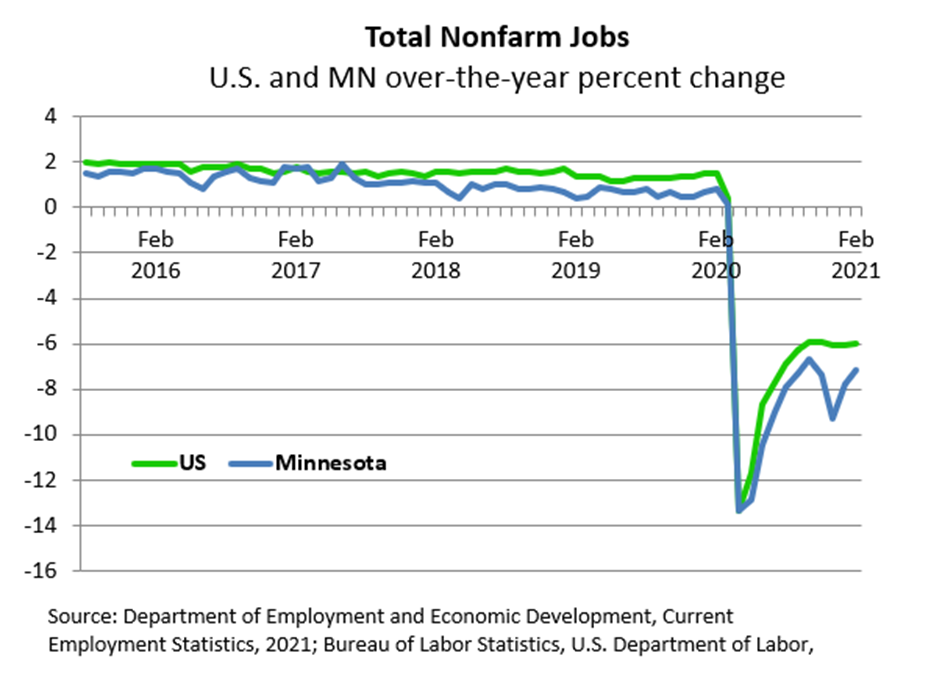by Nick Dobbins
March 2021
Monthly analysis is based on unadjusted employment data.
The Minneapolis-St. Paul-Bloomington MSA added 7,526 jobs or 0.4% over the month in February. This slightly lagged the statewide growth of 0.7%. Leisure and Hospitality posted the largest proportional job increase, up 4% (4,716 jobs), while Government employers had the largest real job increase, adding 5,488 or 2.3%. Educational and Health Services added 4,635 jobs (1.4%) with most of that growth coming within the Educational Services component (up 3,497 or 8.3%). Mining, Logging, and Construction employment was down 4.5% (3,391), and Trade, Transportation, and Utilities was down 1.2% (2,323 jobs) with losses in all three component sectors.
Over the year the metro area lost 171,331 jobs (8.5%) in February. This was the worst proportional growth of any MSA in the state, but also an improvement over January's 8.8% decrease. The metro area has struggled relative to the state overall throughout the COVID-19 situation, posting worse over-the-year declines in every month since April 2020 after posting better numbers the first three months of the year. Declines were once again steepest in Leisure and Hospitality, down 59,262 or 32.5%, which was also notably worse than the statewide decline of 26.1% in the supersector. Other Services was the only other supersector with losses of greater than 10%, off by 12.8% or 10,061 jobs on the year. Financial Activities had the strongest growth, down just 95 jobs or 0.1 percent since February 2020.
The Duluth-Superior MSA added 2,246 jobs (1.8%) in February. This was the strongest monthly growth of any MSA in Minnesota. Leisure and Hospitality drove the growth, adding 1,772 jobs or 17.7% on the month. Educational and Health Services and Government employment were both up 1.8% or 582 and 433 jobs, respectively. Growth was tempered by losses in Mining, Logging, and Construction (down 352 or 4.2%), and Trade, Transportation, and Utilities (down 332 or 1.4%), with declines in all three component sectors).
On an annual basis the Duluth area lost 8,840 jobs (6.5%), slightly better than the state's 7.2% decline. Bucking the larger trend, the biggest proportional declines were not in Leisure and Hospitality, which was down 14.8% or 2,044 jobs, but in Information (down 16.3% or 209 jobs) and Other Services (down 16.1% or 1,038 jobs). All supersectors in the MSA posted negative annual growth.
The Rochester MSA added 1,186 jobs (1%) in February. The lion's share of the growth came via Leisure and Hospitality (up 820 jobs or 10.7%). Professional and Business Services was up 2.3% (131 jobs), and Government was up 1.4% (165 jobs), primarily at the Local Government level. Trade, Transportation, and Utilities, Manufacturing, and Mining, Logging, and Construction all lost jobs on the month.
Over the year the Rochester area lost 5,911 jobs or 4.8%. This was the strongest over-the-year growth of any MSA primarily in Minnesota, behind Fargo-Moorhead at 4.1%. Professional and Business Services actually added jobs on the year, up 220 or 4%. The steepest declines were once again in Leisure and Hospitality, which was down 22.4% or 2,452 jobs.
The St. Cloud MSA added 1,147 jobs or 1.1% in February. The largest real and proportional growth came in Leisure and Hospitality, which was up by 676 jobs or 12.6%. The largest real and proportional losses were in Mining, Logging, and Construction, off by 107 jobs or 1.7%. Five supersectors posted positive monthly growth, and five posted negative growth.
Over the year the MSA lost 6,515 jobs (5.9%). As was the case in most places, the losses were worst in Leisure and Hospitality, which was down 26.5% or 2,176 jobs. Manufacturing lost 1,487 jobs (9.7%), and Other Services employment was down 11% (434 jobs). Mining, Logging, and Construction was the only supersector with positive annual growth, adding 211 jobs or 3.5%.
The Mankato-North Mankato MSA added 95 jobs or 0.2% in February. This was the worst proportional over-the-month growth of any MSA primarily in Minnesota. Government employers added 236 jobs (2.5%), but the growth was tempered by the loss of 141 jobs (0.3%) among private sector employers.
On an annual basis the Mankato-North Mankato area lost 4,455 jobs or 7.6%, slightly worse than the state's 7.2% decline. Losses were worse among goods producers than service providers (off 11.1% versus 6.8%). Private sector employers shed 4,134 jobs (8.5%), while public sector employment was off by 321 or 3.2%.
The Fargo-Moorhead MSA added 1,028 jobs or 0.7% over the month in February. Leisure and Hospitality added 655 jobs (5.7%), and Government employers added 775 jobs (4.3%), with most of that growth coming at the State Government level. Mining, Logging, and Construction employers shed 502 jobs (5.8%).
Over the year the Fargo-Moorhead area lost 5,878 jobs (4.1%). This was the strongest over-the-year growth of any MSA in the state. Multiple supersectors added jobs on the year, led by Mining, Logging, and Construction which was up by 9.5% or 703 jobs. Leisure and Hospitality was down 2,046 or 14.4%, the largest real and proportional decline of any supersector in the area.
The Grand Forks-East Grand Forks MSA added 803 jobs (1.6%) in February. Government employers added 400 jobs (3.2%), mostly at the State and Local levels, and Trade, Transportation, and Utilities added 255 jobs (2.6%), with Retail Trade up 193 (3%) and Transportation, Warehousing, and Utilities up 67 (3.9%).
Over the year the Grand Forks-East Grand Forks area lost 3,433 jobs (6.3%). Leisure and Hospitality had the largest real and proportional declines, off 19.3% or 1,173 jobs. Every supersector in the MSA lost jobs on the year.
